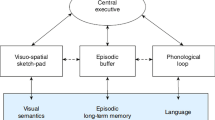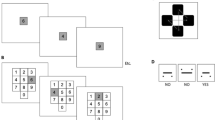Abstract
The paper investigates the involvement of verbal and visuo-spatial working memory during the processing of spatial texts via a dual-task paradigm. Subjects were presented with three texts describing locations from a route perspective, and had either to imagine themselves moving along a route in surroundings or to rehearse verbal information. Concurrently they had to perform a spatial tapping task, an articulatory task, or no secondary task. Performance on a verification test used to assess the product of comprehension showed that the concurrent tapping task impaired performance in the imagery instructions group but not in the repetition instructions group, and caused the beneficial effect of imagery instructions to vanish. This result was not observed with the articulatory task, where interference effects were similar in both instructions groups. Performance on the concurrent tasks confirmed the pattern obtained with the verification test. In addition, results seem partly dependent on the capacity of spatial working memory as measured by the Corsi Blocks Test. We argue that these results clarify the processes of the construction of a spatial mental model, and confirm that the visuo-spatial working memory is involved in mental imagery.


Similar content being viewed by others
References
Anderson, R. C., & Kulhavy, R. W. (1972). Imagery and prose learning. Journal of Educational Psychology, 63(3), 242–243.
Baddeley, A. D. (1986). Working memory. Oxford: Oxford University Press.
Baddeley, A. D., & Logie, R. (1999). Working memory: The multiple-component model. In A. Miyake & P. Shah (Eds.), Models of working memory: Mechanisms of active maintenance and executive control (pp. 28–61). New York: Cambridge University Press.
Bryant, D. J., Tversky, B., & Franklin, N. (1992). Internal and external spatial frameworks for representing described scenes. Journal of Memory and Language, 31, 74–98.
Conte, A., Cornoldi, C., Pazzaglia, F., & Sanavio, S. (1995). Lo sviluppo della memoria di lavoro visuospaziale e il suo ruolo nella memoria spaziale [The development of the visuo-spatial working memory and its role in spatial memory]. Ricerche di Psicologia, 19, 95–113.
De Beni, R., & Moé, A. (2003). Presentation modality effects in studying passages. Are mental images always effective? Applied Cognitive Psychology, 17, 309–324.
De Beni, R., Palladino, P., Pazzaglia, F., & Cornoldi, C. (1998). Increases in intrusion errors and working memory deficit of poor comprehenders. Quarterly Journal of Experimental Psychology: Human Experimental Psychology, 51A(2):305–320.
De Beni, R., Pazzaglia, F., Gyselinck, V., & Meneghetti, C. (2005). Visuospatial working memory and mental representation of spatial descriptions. European Journal of Cognitive Psychology, 17(1), 77–95.
De Vega, M. (1994). Characters and their perspectives in narratives describing spatial environments. Psychological Research, 56, 116–126.
Denis, M. (1991). Image and cognition. New York: Harvester Wheatsheaf.
Denis, M. (1996). Imagery and the description of spatial configurations. In M. de Vega, M.J. Intons-Peterson, P. N. Johnson-Laird, M. Denis & M. Marschark (Eds.), Models of visuospatial cognition (pp. 128–197). New York: Oxford University Press.
Denis, M. (1997). The description of routes: A cognitive approach to the production of spatial discourse. Cahiers de Psychologie Cognitive/Current Psychology of Cognition, 16, 409–458.
Denis, M., & De Vega, M. (1993). Modèles mentaux et imagerie mentale [Mental models and mental imagery]. In M.-F. Ehrlich, H. Tardieu, M. Cavazza (Eds.), Les modèles mentaux: Approche cognitive des représentations (pp. 79–100). Paris: Masson.
Deyzac, E., Logie, R. H., & Denis, M. (2006). Visuo-spatial working memory and the processing of directional instructions. British Journal of Psychology (in press).
Farmer, E. W., Berman, J. V., & Fletcher, Y. L. (1986). Evidence for a visuo-spatial scratchpad in working memory. Quarterly Journal of Experimental Psychology, 38A, 675–688.
Fraisse, P., & Léveillé, M. (1975). Importance du codage visuel de phrases sur leur mémorisation à court terme [The importance of visual coding of sentences on their short term memory]. Année Psychologique, 75, 409–416.
Friedman, N. P., & Miyake, A. (2000). Differential roles for visuospatial and verbal working memory in situation model construction. Journal of Experimental Psychology: General, 129(1), 61–83.
Giesen, C., & Peeck, J. (1984). Effect of imagery instructions on reading and retaining a literary text. Journal of Mental Imagery, 8(2), 79–90.
Gyselinck, V., Cornoldi, C., Dubois, V., De Beni, R., & Ehrlich, M. F. (2002). Visuospatial memory and phonological loop in learning from multimedia. Applied Cognitive Psychology, 16, 665–685.
Haenggi, D., Kintsch, W., & Gernsbacher, M. A. (1995). Spatial situation models and text comprehension. Discourse Processes, 19(2), 173–199.
Johnson-Laird, P.N. (1983). Mental models. Cambridge: Harvard University Press.
Just, M.A., & Carpenter, P.A. (1992). A capacity theory of comprehension: Individual differences in working memory. Psychological Review, 99, 122–149.
Logie, R. H. (1995). Visuo-spatial working memory. Hillsdale: Lawrence Erlbaum Associates.
Miyake, A., & Shah, P. (1999). Emerging general consensus, unresolved theoretical issues, and future research directions. In A. Miyake, & P. Shah (Eds.). Models of working memory: mechanisms of active maintenance and executive control (pp. 1–27). New York: Cambridge University Press.
Noordzij, M. L., van der Lubbe, R. H. J., Neggers, S. F. W, & Postma, A. (2004). Spatial tapping interferes with the processing of linguistic spatial relations. Canadian Journal of Experimental Psychology, 58, 259–271.
Paivio, A. (1971). Imagery and verbal processes. New York: Holt, Rinehart and Winston.
Pazzaglia, F., Cornoldi, C., & Longoni, A.M. (1994). Limiti di memoria e specificità di rappresentazione nel ricordo di descrizioni spaziali “dall’alto” ed “entro il percorso” [Limits of memory and specificity of representations in the recall of survey and route descriptions]. Giornale Italiano di Psicologia, 21, 267–286.
Pazzaglia, F., De Beni, R., & Meneghetti, C.(2006). The effects of verbal and spatial interference in the encoding and retrieval of spatial and non-spatial texts. Psychological Research (in press).
Pearson, D. G. (2001). Imagery and the visuo-spatial sketchpad. In J. Andrade (Ed.), Working memory in perspective (pp. 33–59). Hove: Psychology Press.
Perrig, W., & Kintsch, W. (1985). Propositional and situational representations of text. Journal of Memory and Language, 24, 503–518.
Richardson, J. T. E. (1998). The availability of effectiveness of reported mediators in associative learning: a historical review and an experimental investigation. Psychonomic Bulletin and Review, 5, 597–614.
Riding, R. J., & Calvey, I. (1981). The assessment of verbal-imagery learning styles and their effect on the recall of concrete and abstract prose passages by 11–year-old children. British Journal of Psychology, 72, 59–64.
Schneider, L. F., & Taylor, H. A. (1999). How do you get there from here? Mental representations of route descriptions. Applied Cognitive Psychology, 13(5), 415–441.
Taylor, H.A., & Tversky, B. (1992). Spatial mental models derived from survey and route descriptions. Journal of Memory and Language, 31, 261–292.
Vandierendonck, A., & De Vooght, G. (1997). Working memory constraints on linear reasoning with spatial and temporal contents. Quarterly Journal of Experimental Psychology, 50A, 803–820.
Author information
Authors and Affiliations
Corresponding author
Rights and permissions
About this article
Cite this article
Gyselinck, V., De Beni, R., Pazzaglia, F. et al. Working memory components and imagery instructions in the elaboration of a spatial mental model. Psychological Research 71, 373–382 (2007). https://doi.org/10.1007/s00426-006-0091-1
Received:
Accepted:
Published:
Issue Date:
DOI: https://doi.org/10.1007/s00426-006-0091-1




